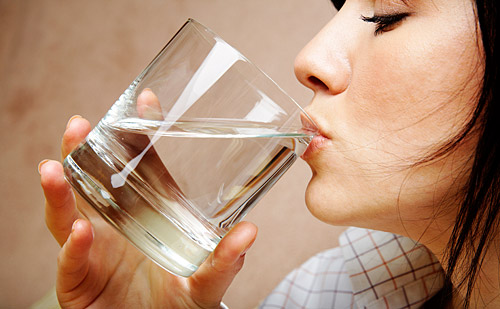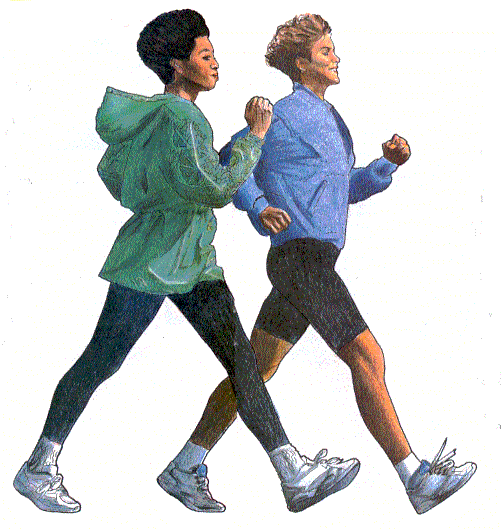How often have you read fitness articles or are told in your fitness class to work at an RPE of 7, for example, or to work at a moderate pace and never really understood how hard that is meant to be? Here is a practical measure of what those levels actually mean...
RPE 1-2: Very easy - you can converse with no effort.
RPE 3: Easy - you can converse with almost no effort.
RPE 4: Moderately Easy - you can converse comfortably with little effort.
RPE 5: Moderate - conversation requires some effort.
RPE 6: Moderately hard - conversation requires quite a bit of effort.
RPE 7: Difficult - conversation requies a lot of effort.
RPE 8: Very Difficult - conversation requires maximum effort.
RPE 9-10: Peak Effort - no talking zone!
A complete guide to looking good and feeling great...for women who weren't born yesterday!
Friday, April 30, 2010
Thursday, April 22, 2010
How Much Water Do You Need To Drink?
How can you make sure you’re getting enough water for optimal health? Should you rely on thirst alone, or is it best to abide by the eight-glasses-a-day rule?
The truth is, either approach will probably work just fine — for the most part. But your water and fluid needs can vary, depending on your activity level, the weather and environmental conditions, even the medications you may be taking. The consumption of caffeine and alcohol can also increase your body's demand for water.
Getting to know which situations are likely to increase your need for fluids can help you stay sufficiently hydrated. But don’t go overboard. There’s no point in drinking more water than you need, just for the sake of it. At the very least, you’ll end up running to the bathroom every 10 minutes. At worst, you could put yourself at risk of a life-threatening condition called hyponatremia, or water intoxication.
Too Much of a Good Thing? Under normal circumstances, a healthy body can process large amounts of water as long as it also has plenty of electrolytes, in particular, sodium. But the combination of too much water and not enough sodium can cause problems. Those at highest risk of developing hyponatremia are:
• Endurance athletes who lose large amounts of sodium through sweating and then flood their bodies with too much fluid as they try to rehydrate
I believe that water is the only drink for a wise man. ~Henry David Thoreau
The truth is, either approach will probably work just fine — for the most part. But your water and fluid needs can vary, depending on your activity level, the weather and environmental conditions, even the medications you may be taking. The consumption of caffeine and alcohol can also increase your body's demand for water.
Getting to know which situations are likely to increase your need for fluids can help you stay sufficiently hydrated. But don’t go overboard. There’s no point in drinking more water than you need, just for the sake of it. At the very least, you’ll end up running to the bathroom every 10 minutes. At worst, you could put yourself at risk of a life-threatening condition called hyponatremia, or water intoxication.
Too Much of a Good Thing? Under normal circumstances, a healthy body can process large amounts of water as long as it also has plenty of electrolytes, in particular, sodium. But the combination of too much water and not enough sodium can cause problems. Those at highest risk of developing hyponatremia are:
• Endurance athletes who lose large amounts of sodium through sweating and then flood their bodies with too much fluid as they try to rehydrate
• People with kidney problems
• People over 65 years old who take multiple medications or have health conditions that compromise the body’s ability to get rid of fluids or maintain adequate sodium levels
Although rare, hyponatremia can also occur as a result of unsafe crash dieting or binge beer-drinking.
Wednesday, April 14, 2010
Pair Up...to Slim Down!
You may not have set any exercises goals back in January, but chances are you will now, what with summer - and more revealing clothes - right around the corner. One strategy that can help you get in shape fast while upping the fun factor: Find a workout partner.
It makes you accountable to someone, so you're more apt to show up: it helps you pass the time on the treadmill or going for a run/walk; and it can prompt you to push yourself. Try these "buddy up" tips below to maximize your workout relationships...
It makes you accountable to someone, so you're more apt to show up: it helps you pass the time on the treadmill or going for a run/walk; and it can prompt you to push yourself. Try these "buddy up" tips below to maximize your workout relationships...
- Choose the right person. Whether it is a friend, relative or member of your running group, look for womeone who is excited about working out and seems knowledgable about fitness. Notice I didn't mention boyfriend or husband....statistics show that these don't always make the best workout relationships as it can cause more conflict that it's worth. There are exceptions to every rule, of course, so if you and your signifcant other workout well together...then GO FOR IT!!!
- Use your partner for strength and flexibility moves. Stretch together, throw the medicine ball to each other or use the opposite ends of tubing for great workouts. Use your imagination!
- Challenge each other. Use cardio machines side-by-side and see who finishes 500 m the fastest, or who finishes 20 push ups first. This is an ideal opportunity to push your limits and have some friendly competition spur you on.
- Play follow the leader. Take turns deciding on the workout. One day you lead the workout, the next your partner does!
- Use each other for inspiration. Talk about the changes you see ("Wow, your abs are looking great!") to encourage the other person. Or, use your partner's good results to fuel your motivation.
- Let your buddy be strong when you're not. If you go out for a post-workout dinner and are tempted by the Fettucine Alfredo, let your partner order something healthy for you!
Subscribe to:
Posts (Atom)


